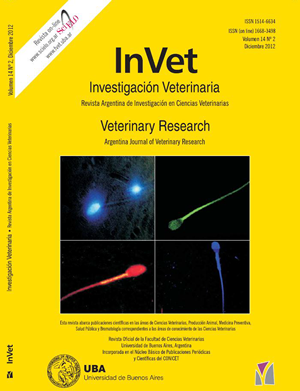Ver ítem
- xmlui.general.dspace_homeCentros Regionales y EEAsCentro Regional CórdobaEEA Marcos JuárezArtículos científicosxmlui.ArtifactBrowser.ItemViewer.trail
- Inicio
- Centros Regionales y EEAs
- Centro Regional Córdoba
- EEA Marcos Juárez
- Artículos científicos
- Ver ítem
RYR1 gene variability and effect on meat pH in Argentinean hybrids swines = Variabilidad del gen RYR1 y efecto en el pH de la carne en cerdos híbridos argentinos
Resumen
The RYR1 gene is the principal cause of the porcine stress syndrome (PSS) and the presence of pale, soft and exudative meat (PSE) in swine. In Argentina there are no reports about the variability of RYR1 gene in hybrid swine and its effect on the quality of carcass. By PCR-HRM we analyzed 403 hybrids swines from Argentina and 65.0% were homozygous NN, 30.8% heterozygous Nn and 4,2% homozygous nn. Additionally, a significant effect (p <0.0001) of the RYR1
[ver mas...]
The RYR1 gene is the principal cause of the porcine stress syndrome (PSS) and the presence of pale, soft and exudative meat (PSE) in swine. In Argentina there are no reports about the variability of RYR1 gene in hybrid swine and its effect on the quality of carcass. By PCR-HRM we analyzed 403 hybrids swines from Argentina and 65.0% were homozygous NN, 30.8% heterozygous Nn and 4,2% homozygous nn. Additionally, a significant effect (p <0.0001) of the RYR1 gene was detected on the pH of carcass at 45 minutes after slaughter. Normal genotypes NN showed the highest pH values at 45 minutes after slaughter (6.27), heterozygous Nn showed intermediate pH values (5.94) and homozygous susceptible nn showed the lowest pH values (5.64). Argentina present high incidence of Nn and nn genotypes for the RYR1 gene in relation to Brazil, the principal pig producer of Latin America. Additionally the RYR1 gene affects the pH of the meat, one of the principal parameters in the determination of the PSE meat.
[Cerrar]
El gen RYR1 es la principal causa del síndrome de estrés porcino (PSS) y la presencia de carne pálida, blanda y exudativa (PSE) en los cerdos. En Argentina no existen informes sobre la variabilidad de dicho gen en cerdos híbridos y su efecto sobre la calidad de la canal. Por PCR-HRM se analizaron 403 cerdos híbridos de Argentina y el 65,0% eran homocigotos NN, 30.8% heterocigotos Nn y el 4,2% homocigotos nn. Además, se detectó un efecto significativo (p
[ver mas...]
El gen RYR1 es la principal causa del síndrome de estrés porcino (PSS) y la presencia de carne pálida, blanda y exudativa (PSE) en los cerdos. En Argentina no existen informes sobre la variabilidad de dicho gen en cerdos híbridos y su efecto sobre la calidad de la canal. Por PCR-HRM se analizaron 403 cerdos híbridos de Argentina y el 65,0% eran homocigotos NN, 30.8% heterocigotos Nn y el 4,2% homocigotos nn. Además, se detectó un efecto significativo (p <0,0001) del gen RYR1 en el pH de la canal a los 45 minutos post faena. Los genotipos NN mostraron los mayores valores de pH a los 45 minutos después del sacrificio (6.27), los heterocigotos Nn mostraron valores intermedios de pH (5,94) y los homocigotos nn presentaron los valores más bajos de pH (5,64). Argentina presenta alta incidencia de los genotipos Nn y nn del gen RYR1 en relación a Brasil, el principal productor de cerdos de América Latina. Además, el gen RYR1 afecta al pH de la carne, uno de los principales parámetros para la determinación de carnes PSE.
[Cerrar]

Fuente
InVet 14 (1) : 19-23 (2012)
Fecha
2012
Editorial
Facultad de Ciencias Veterinarias, Universidad de Buenos Aires
ISSN
1514-6634
1668-3498
1668-3498
Formato
pdf
Tipo de documento
artículo
Palabras Claves
Derechos de acceso
Abierto
 Excepto donde se diga explicitamente, este item se publica bajo la siguiente descripción: Creative Commons Attribution-NonCommercial-ShareAlike 2.5 Unported (CC BY-NC-SA 2.5)
Excepto donde se diga explicitamente, este item se publica bajo la siguiente descripción: Creative Commons Attribution-NonCommercial-ShareAlike 2.5 Unported (CC BY-NC-SA 2.5)


